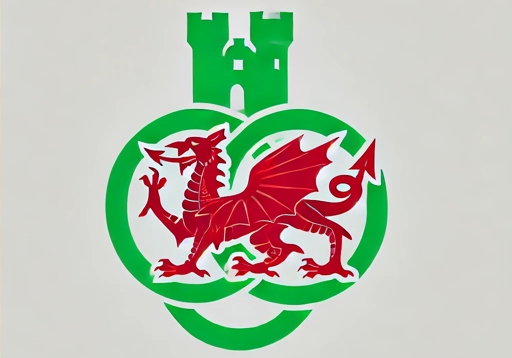Owain Glyndŵr’s 120 men triumphed over 1,500 English soldiers at Mynydd Hyddgen in June 1401. This victory, leaving 200 Englishmen dead, was a highlight in the long history of Medieval rebellions of Wales against English rule. It showcases the resilience and bravery of the Welsh people during the medieval era.
The early battles against Norman invaders and Owain Glyndŵr’s uprising are key moments in Welsh history. These events have deeply influenced the nation’s identity. The struggle for freedom and Welsh independence was relentless, with leaders like Llywelyn the Great and Llywelyn ap Gruffudd at the forefront.
Edward I’s occupation of Wales in 1283 sparked widespread resentment. This resentment was the catalyst for Glyndŵr’s rebellion in 1400. Starting with an assembly at Glyndyfrdwy and an attack on Baron Grey’s estates at Ruthin, the rebellion quickly gained strength. Glyndŵr’s victories against the English were decisive.
The Battle of Bryn Glas on June 22, 1402, saw Glyndŵr’s 1,500 men defeat Sir Edmund Mortimer’s 2-4,000 English soldiers. This victory, coupled with Mortimer’s capture, led to his alliance with Glyndŵr. This alliance significantly threatened English dominance over Wales.
Timeline of the Medieval Rebellions of Wales
- 1066: Norman Conquest of England – The Norman invasion of England sets the stage for future conflicts with Wales.
- 1070s-1090s: Norman Incursions into Wales – The Normans begin expanding into Welsh territories, establishing castles and strongholds.
- 1136: Battle of Crug Mawr – Welsh forces win a significant victory near Cardigan, boosting morale and inspiring further resistance.
- 1170-1240: Reign of Llywelyn the Great – Llywelyn ap Iorwerth unifies much of Wales, negotiating treaties with England to establish himself as Prince of Wales.
- 1277-1283: Edward I’s Conquest of Wales – King Edward I launches a full-scale conquest, resulting in the annexation of Wales and the building of powerful castles.
- 1284: Statute of Rhuddlan – Edward I enacts laws integrating Wales into the English legal and administrative system, suppressing Welsh autonomy.
- 1294-1295: Rebellion of Madog ap Llywelyn – A Welsh uprising against English rule, led by Madog ap Llywelyn, temporarily disrupts English control.
- 1316: Llywelyn Bren’s Uprising – Llywelyn Bren leads a rebellion in South Wales, challenging oppressive English governance.
- 1400-1415: Owain Glyndŵr’s Rebellion – Owain Glyndŵr leads the most famous Welsh revolt, declaring himself Prince of Wales and fighting for independence.
Medieval Rebellions Of Wales: The Rise of Welsh
Following the Norman conquest of England in 1066, their sights turned to Wales. The creation of earldoms like Chester, Shrewsbury, and Hereford marked the start of the Norman invasion of Wales. The Normans, despite acknowledging Welsh rulers, gradually expanded their dominion. They established key lordships such as Cardigan, Pembroke, Brecon, and Glamorgan.
The Welsh people’s resistance was fierce, defending their lands, cultural preservation, and way of life. Between 1081 and 1267, English monarchs launched 21 expeditions into Wales. Yet, Gwynedd and Powys managed to re-emerge as political entities after conflicts, achieving stability by 1093.
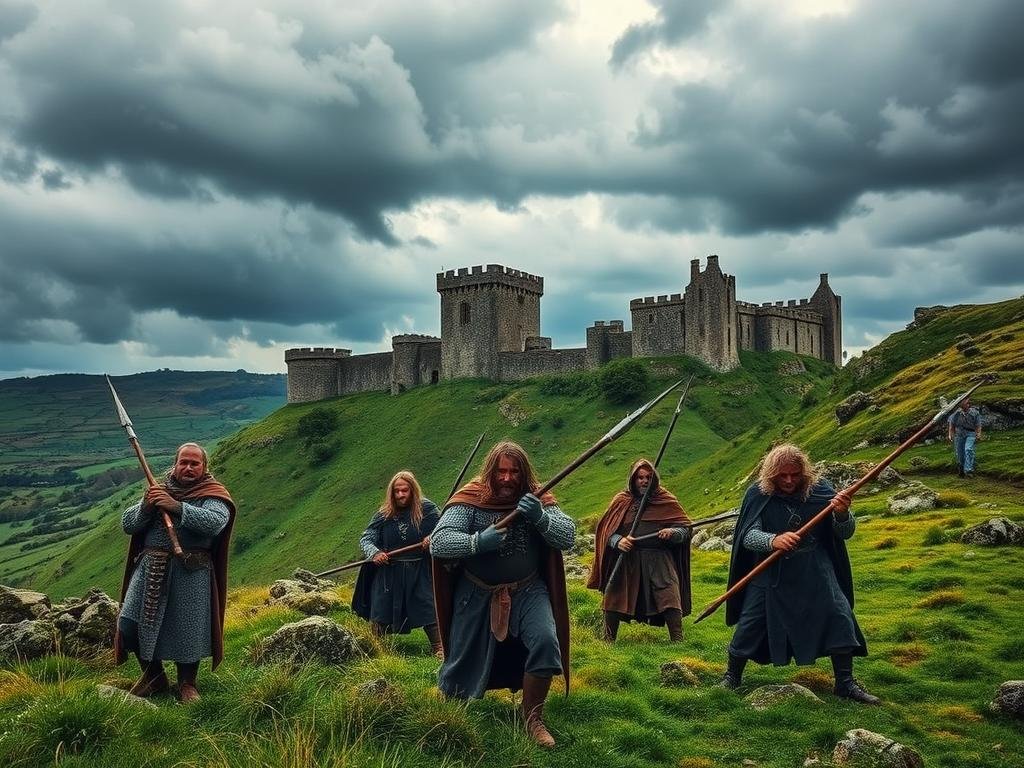
The marcher lords, Norman nobles in the borderlands, were key players in the Welsh-English struggle. Rhys ap Gruffudd, a notable Welsh leader, secured recognition from Henry II, allowing him to govern Deheubarth. This era also saw a cultural resurgence, with Latin scholarship and literature flourishing in Wales.
The Welsh people’s resolve to maintain their Welsh identity and resist foreign rule was unwavering. The clergy of Bangor, backed by Welsh leaders, refused to submit to Canterbury. This resistance set the stage for the emergence of legendary Welsh leaders, who would fight for their people’s freedom and autonomy.
Norman Conquest and Welsh Subjugation
The Anglo-Norman settlement of Wales was a slow and uneven process, characterised by phases of military conquest and periods of uneasy coexistence.”
– John Davies, A History of Wales
The Norman conquest of England in 1066 had a significant impact on Wales. The new rulers aimed to expand their control over the neighbouring nation. The Normans gradually moved into Wales, conquering and settling areas like Pembroke and the Vale of Glamorgan in southern Wales during the 1080s and 1090s. welcome to the seed of the medieval rebellions of Wales.
King Henry I promoted large-scale Norman settlement in south Wales. He built the first royal castle at Carmarthen in 1109. By the 13th century, most of Wales was under Norman and Anglo-Norman rule, except for the principality of Gwynedd, which remained theoretically independent.
Welsh Territories Under Norman Control
The marcher lords were given extraordinary powers to rule their territories autonomously, which created a unique kind of quasi-independent rule that shaped Welsh society and resistance for centuries.”
– J. Beverley Smith, Llywelyn ap Gruffudd: The Last Prince of Wales
Before Edward I’s conquest in 1276, Wales was divided into three zones. The outer zone was controlled by the ‘Marcher’ lords, descendants of the advancing Norman barons. These marcher lordships were set up to secure Norman territories and suppress Welsh resistance.
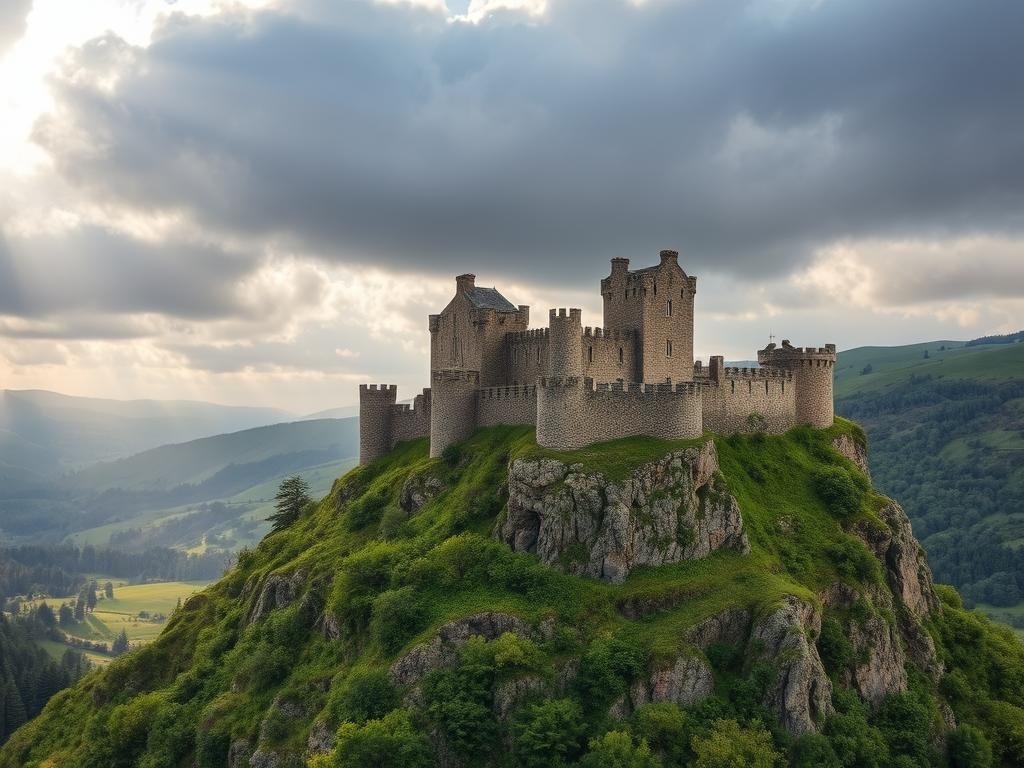
By Henry III’s reign (1216-1272), Wales was seen as a ‘half-conquered country’. Norman lords ruled, while most settlers were Saxon-English. Llywelyn the Great, who ruled most of Wales for 20 years in the 13th century, allied with Simon de Montfort. He was acknowledged as the Prince of Wales, reaching the peak of his power.
Norman Castles as Symbols of Oppression
Norman castles were as much instruments of psychological warfare as military ones. They were designed to intimidate the local population, reminding them daily of their subjugation.”
– R.R. Davies, The Age of Conquest: Wales 1063-1415
William I and his heirs built hundreds of Norman castles across the British Isles. These fortifications, such as Flint, Rhuddlan, and Caernarfon, were symbols of power and control. They served as focal points for Anglo-Norman expansion and were seen as symbols of oppression by the Welsh. Us welsh don’t do too well with oppression.
The design of these castles, often influenced by continental styles, was the work of skilled masons from Savoy. Master Mason James of St. George directed the construction. The presence of these fortresses throughout Welsh territories was a constant reminder of Norman subjugation and the Welsh struggle for freedom.
Early Medieval Rebellions Of Wales
In the late 11th and early 12th centuries, the Welsh faced harsh rule by Norman invaders. They sought to regain their lands and maintain their freedom. This led to a series of early Welsh rebellions, significantly influencing the nation’s history.

Gruffudd ap Cynan and the Kingdom of Gwynedd
Gruffudd ap Cynan, a Welsh prince, was a key figure in these rebellions. Born into royalty, he aimed to reclaim his kingdom and liberate his people from Norman rule. His lineage and determination drove him to fight for decades.
Gruffudd’s strategy, military skills, and resolve helped rebuild Gwynedd. This kingdom became a stronghold against Norman invaders. His efforts paved the way for future Welsh leaders to pursue freedom.
Battles Against Norman Invaders
The early medieval rebellions of Wales were characterised by intense battles against the Normans. Welsh warriors used innovative tactics to challenge the Normans’ military advantage. Battles raged across Gwynedd’s hills and the south’s valleys, with Welsh cries of defiance echoing through the land.
In 1136, Gruffudd ap Rhys won a significant victory against the English near Cardigan. This victory boosted Welsh morale and showcased the success of their guerrilla warfare against the Norman armour.
Despite brutal Norman reprisals, these rebellions galvanised the Welsh spirit of resistance. They paved the way for future uprisings and inspired Welsh leaders to continue the fight for independence.
The Age of the Princes
In the 13th century, Wales saw the emergence of powerful princes. They aimed to unite the fragmented Welsh kingdoms against English domination. This era, known as the age of princes, was marked by leaders like Llywelyn the Great. They worked hard for Welsh unity and consolidation of power.

Llywelyn the Great, or Llywelyn ap Iorwerth, became a key figure. As Prince of Gwynedd, he expanded his influence over Wales. His diplomatic skills and military strength allowed him to negotiate with English kings, securing recognition as Wales’ leading ruler.
The age of princes was a time of effort to keep Welsh identity and autonomy against English expansion. Llywelyn and other leaders strengthened their kingdoms through strategic alliances and fortifications. This era also saw a growth in Welsh culture, with support for bards and the codification of Welsh law.
Despite Llywelyn’s efforts, resistance to English rule was ongoing. The Welsh princes fought against English monarchs trying to control Wales. The Statute of Rhuddlan, introduced by Edward I in 1284, tried to integrate Wales into the English legal system. Yet, the Welsh desire for independence remained strong.
The age of princes was a critical time in Welsh history. It was a period of intense pursuit of Welsh unity and self-determination. The legacy of Llywelyn the Great continues to inspire the Welsh, reminding them of their heritage and the ongoing fight for freedom.
Llywelyn the Great: Uniting Wales
Llywelyn the Great’s achievements were the first serious attempt by a Welsh leader to unify Wales, establishing a sense of national identity that had been fragmented by years of internal divisions.”
– Gwynfor Evans, Land of My Fathers: 2000 Years of Welsh History
In the late 12th century, a remarkable Welsh leader emerged, changing Welsh history forever. Llywelyn ap Iorwerth, known as Llywelyn the Great, became the Prince of Gwynedd. He aimed to unite the fractured Welsh kingdoms under his rule. His military skill, diplomacy, and determination led to a unified Welsh polity.

Consolidation of Welsh Power
Llywelyn’s journey to greatness started in 1195, after his uncle Dafydd ab Owain’s death. Over 45 years, he dominated Welsh politics, navigating alliances and conflicts. In 1216, he convened a council at Aberdyfi, distributing lands to other princes, solidifying his rule.
Treaty of Woodstock
Llywelyn’s growing power caught the English crown’s attention. In 1247, he negotiated the Treaty of Woodstock with King Henry III. This treaty recognised Llywelyn’s authority over Welsh princes, marking a significant milestone in Welsh history.
Conflicts with Henry III of England
Despite the Treaty of Woodstock, Llywelyn’s relationship with the English crown remained tense. Henry III sought to limit Llywelyn’s power, fearing his growing influence. This led to conflicts, as Llywelyn fought to protect his independence. Through military victories and diplomacy, he managed to keep the English at bay.
Llywelyn ap Gruffudd: The Last Prince of Wales
In Welsh history, Llywelyn ap Gruffudd stands out as the last native Prince of Wales. Born around 1223 in Gwynedd, his reign started in 1258 and ended with his death in 1282. As the grandson of Llywelyn the Great, he fought to keep Wales free from English rule.
Llywelyn’s journey to power was challenging. In 1247, he signed the Treaty of Woodstock, losing half of Gwynedd to the English. Yet, he defeated rivals Owain and Dafydd in 1255, securing his rule over Gwynedd Uwch Conwy. By 1258, he proudly called himself ‘Prince of Wales’.
The last prince of wales faced his biggest foe in Edward I of England. Despite efforts to make peace, including the Treaty of Montgomery in 1267, tensions were high. In 1277, Edward declared Llywelyn a rebel and invaded Wales, leading to the Treaty of Aberconwy, which limited his rule to East Gwynedd.
Llywelyn refused to give up. When the Welsh in East Gwynedd rebelled, he marched south to face Edward’s forces. He was killed in battle at Orewin Bridge in 1282. His death marked the end of Welsh independence and the medieval rebellions of Wales (for now), with Edward’s son becoming the new ‘Prince of Wales’.
The fall of Welsh independence was a hard pill to swallow. Yet, Llywelyn ap Gruffudd’s legacy as a champion of Welsh freedom remains strong. His fight to resist English rule and preserve Welsh autonomy has made him a national hero. Though he was the last native Prince of Wales, his memory continues to inspire Welsh patriots today.
Edward I and the Conquest of Wales
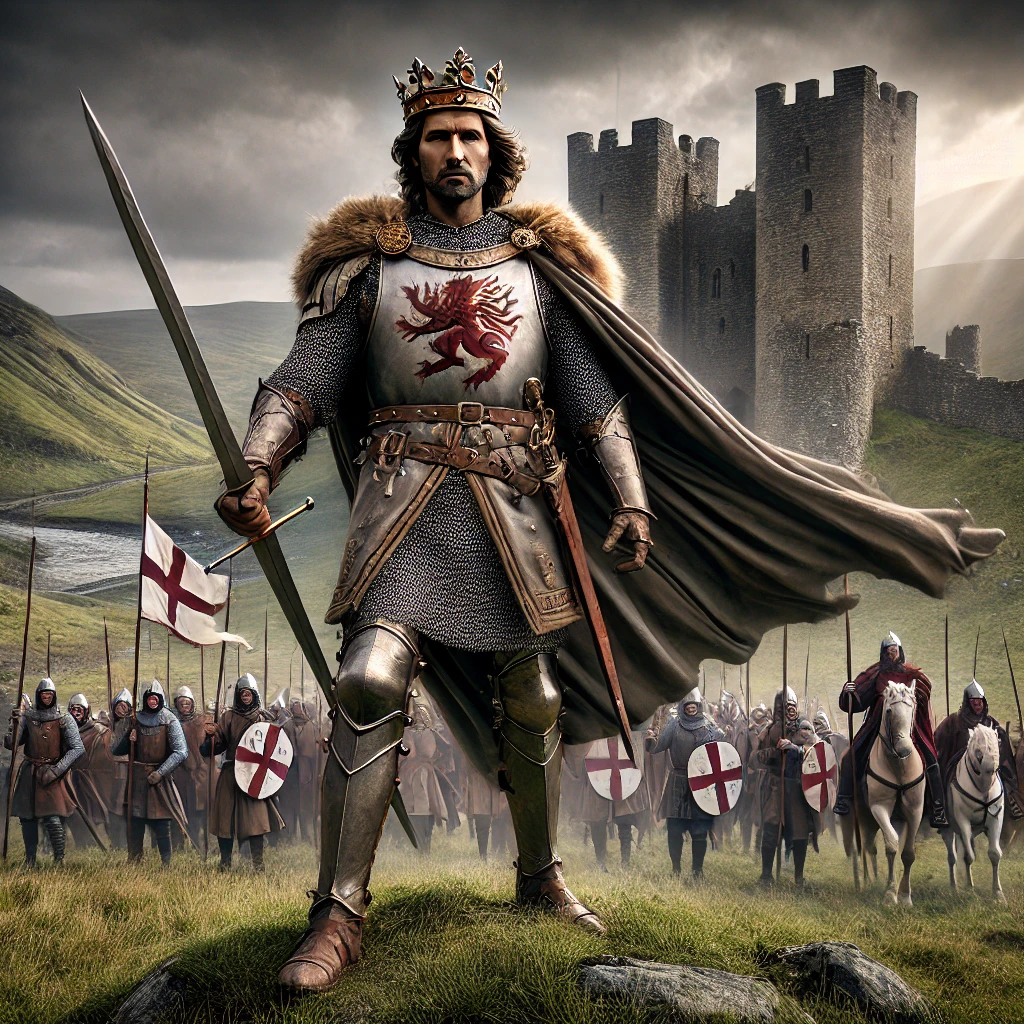
In the late 13th century, King Edward I of England launched a relentless campaign to conquer Wales. His aim was to bring Wales under English domination. This conquest was a turning point in Welsh history, as Edward sought to suppress Welsh culture and establish English rule.
Building of Welsh Castles
Edward I’s castle-building programme was unprecedented, with the scale and quality of the fortifications in Wales serving as the most formidable symbol of English power over a conquered territory.”
– Marc Morris, A Great and Terrible King: Edward I and the Forging of Britain
To secure his control over the conquered Welsh territories, Edward I initiated a massive castle-building programme. He erected imposing fortifications like Caernarfon Castle, Conwy Castle, and Harlech Castle. These castles symbolised English power and dominance, designed to intimidate the Welsh population and deter future rebellions.
The construction of these castles was a monumental undertaking. Conwy Castle, for instance, began construction in October 1283 and was completed in 1297, demonstrating the royal power of the English King. Harlech Castle’s construction started in May 1284, following Edward’s capture of the castle at Criccieth in March of the same year.
Statute of Rhuddlan
The Statute of Rhuddlan was more than a legal act; it was an attempt to reshape Welsh society along English lines, to break Welsh autonomy and impose English control over every aspect of Welsh life.”
– Roger Turvey, The Welsh Princes: The Native Rulers of Wales 1063-1283
In March 1284, Edward I enacted the Statute of Rhuddlan, a key piece of legislation. It formally annexed Wales to the English crown. The statute imposed English law and administration on the conquered nation, effectively subjugating the Welsh people to English rule.
The Statute of Rhuddlan marked a significant step in the suppression of Welsh culture and identity. It aimed to integrate Wales into the English legal system, eroding Welsh customs and traditions. This act of subjugation further solidified English domination over the Welsh people.
Edward I’s conquest of Wales and the subsequent building of welsh castles and implementation of the Statute of Rhuddlan had far-reaching consequences. It marked the beginning of a long period of English domination and the suppression of Welsh culture. The legacy of this conquest continues to shape the complex relationship between England and Wales to this day.
Medieval Rebellions of Wales
Throughout the medieval period, the Welsh people resisted English domination, fighting for their freedom and autonomy. The spirit of resistance burned brightly in the hearts of the Welsh. This gave rise to several notable uprisings that challenged the English conquest.
Madog ap Llywelyn’s Revolt
Madog ap Llywelyn’s 1294 revolt briefly brought about significant victories, capturing English-held territories and reviving hope of independence, albeit short-lived.”
– David Walker, Medieval Wales
In 1294-95, Madog ap Llywelyn led a fierce revolt against English rule. His forces successfully captured several English-held castles, striking a blow to the occupiers. Though short-lived, Madog’s rebellion demonstrated the unwavering determination of the Welsh to resist foreign control.
Llywelyn Bren’s Uprising
The year 1316 saw another significant uprising, led by Llywelyn Bren. This rebellion focused on challenging English authority in south Wales. Llywelyn Bren’s brave stand against the English showcased the ongoing struggle for Welsh independence and the refusal to submit to foreign domination.
Owain Lawgoch: The Last Hope
Owain Lawgoch’s ambition to reclaim the title of Prince of Wales was a lasting reminder of the Welsh resolve to defy English rule even in exile.”
– Sean Davies, The First Prince of Wales? Gruffudd ap Llywelyn and the Battle for Wales
In the late 14th century, Owain Lawgoch emerged as a claimant to the title of Prince of Wales. He sought support from France in his quest to liberate Wales from English rule. Owain Lawgoch represented the last major hope for Welsh independence in the medieval period, embodying the enduring spirit of resistance.
Despite the ultimate defeat of these rebellions, they left an indelible mark on Welsh history. The courage and determination displayed by figures like Madog ap Llywelyn, Llywelyn Bren, and Owain Lawgoch inspired future generations. They continued the fight for Welsh freedom and preserved their unique cultural identity in the face of English domination.
Owain Glyndŵr’s Rebellion

The Battle of Mynydd Hyddgen was a crucial victory for Owain Glyndŵr, solidifying his position as a leader capable of uniting and inspiring the Welsh in their fight for independence.”
– Simon Jenkins, A Short History of England
In Welsh history, Owain Glyndŵr stands out as a towering figure. He led a fierce rebellion (and one of the last major medieval rebellions of Wales) against English rule in the early 15th century. Born around 1350, Glyndŵr became a charismatic leader, rallying the Welsh for independence and self-determination.
Glyndŵr Proclaimed Prince of Wales
In September 1400, at Glyndyfrdwy, Owain Glyndŵr was hailed as the Prince of Wales. This moment marked the start of a rebellion that would unite Wales against English rule.
Capturing English Castles
Glyndŵr’s military skills were evident from the start. In 1401, his forces took Conwy Castle, a key stronghold in North Wales. Later, he defeated an English army at Pumlumon. His army then captured Aberystwyth and Harlech castles in 1404, hitting English power in Wales hard.
Alliance with France
Owain Glyndŵr sought international support, forming an alliance with France in 1404. This move brought vital military aid to the Welsh. Glyndŵr’s ambitions went beyond war; he wanted Welsh-speaking clergy and two universities, aiming for a truly independent Wales.
Though the rebellion didn’t win independence, its impact on Wales was immense. Owain Glyndŵr’s legacy as a national hero and symbol of resistance continues to inspire. He reminds us to hold dear our identity and never give up on freedom.
The Decline of the Medieval Rebellions Of Wales
Despite the valiant efforts of Owain Glyndŵr and his followers, the Welsh rebellions against English rule began to wane in the early 15th century. The decline of rebellions can be attributed to a combination of factors. These include the relentless English suppression, waning support among the Welsh people, and the implementation of harsh penal laws.
The English crown, determined to quell any further uprisings, employed increasingly brutal tactics to subdue the Welsh population. The introduction of oppressive legislation, such as the Penal Laws, aimed to restrict Welsh rights and privileges. This effectively undermined the spirit of resistance. These laws sought to eradicate Welsh culture, language, and traditions, forcing the Welsh people to assimilate into English society.
As the rebellions faced mounting challenges, support among the Welsh populace began to dwindle. The prolonged conflict had taken a heavy toll on the nation, leading to widespread devastation and economic hardship. Many Welsh nobles, once staunch supporters of the rebellions, began to align themselves with the English crown. They sought to protect their own interests and avoid further repercussions.
The final blow to Welsh independence came with the annexation of Wales by the English crown in the 16th century. The Acts of Union, passed during the reign of Henry VIII, formally incorporated Wales into the English legal and political system. This move effectively extinguished any remaining hopes of Welsh self-governance. It marked the end of an era of fierce resistance against English domination.
Though the medieval rebellions of Wales ultimately failed to achieve lasting independence, their legacy endured in the hearts and minds of the Welsh people. The spirit of resistance, embodied by figures like Owain Glyndŵr, became a symbol of Welsh pride and identity. It inspired future generations to preserve their unique cultural heritage in the face of adversity.
Impact of Medieval Rebellions Of Wales on Welsh Identity
The Welsh resistance movements, while ultimately unable to secure complete independence, became embedded in the national psyche, providing a foundation for later expressions of Welsh nationalism.”
– Kenneth O. Morgan, Rebirth of a Nation: Wales 1880-1980
The medieval Welsh rebellions, though they failed to achieve lasting political independence, were key in shaping Welsh identity. Led by figures like Owain Glyndŵr, these uprisings protected Welsh culture, language, and distinctiveness against English rule. Their impact on Welsh identity is profound, fostering national pride and cultural preservation.
The Glyndwr rebellion, in particular, boosted national pride and cultural identity. Despite harsh penalties against Welsh people, the rebellion sparked a rise in nationalism. The legends of these rebellions and their leaders became part of Welsh national mythology, inspiring future generations to fight for recognition and autonomy.
Preservation of Welsh Culture
The medieval Welsh rebellions were essential in preserving Welsh culture. Against English oppression and assimilation attempts, these uprisings kept the Welsh language, traditions, and distinctiveness alive. Poets like Dafydd ap Gwilym and Iolo Goch played a significant role in Welsh literature and cultural expression during this time.
Rise of Welsh Nationalism
The rebellions’ impact on Welsh identity is immense, laying the groundwork for Welsh nationalism. The memories of these uprisings and their leaders, such as Llywelyn the Great and Owain Glyndŵr, are central to Welsh national mythology. Even with the decline of the Welsh language, only a fifth of the population speaks it today, the pride in Welsh identity remains strong. This is thanks to the legacy of these medieval rebellions of Wales.
Legacy of the Welsh Princes
Owain Glyndŵr’s legacy is celebrated to this day, as he embodies the Welsh spirit of independence and defiance against overwhelming odds.”
– John Edward Lloyd, A History of Wales from the Earliest Times to the Edwardian Conquest
The Welsh princes who fought against English rule left a lasting impact on Wales’ history and culture. Leaders like Llywelyn the Great and Owain Glyndŵr became symbols of resistance and pride for the Welsh. Their bravery is celebrated to this day.
Owain Glyndŵr, born around 1354, claimed lineage from Llywelyn the Great. He was the heir to two of Wales’ four great princely houses. At 50, he led a rebellion against Henry IV, claiming the title Prince of Wales.
Glyndŵr’s rebellion lasted over a decade, drawing thousands of Welsh to his cause. They sought to end English rule. This period is a testament to Welsh determination and resilience.
The stories of these cultural icons have been celebrated for centuries. They are woven into Wales’ national identity. Their bravery and defiance continue to inspire future generations, highlighting Wales’ rich history and unique culture.
The legacy of the princes is evident across Wales. Ruined castles and annual commemorations honour their memory. In 2000, the 600th anniversary of Owain Glyndŵr’s rising was celebrated nationwide. His standard was displayed at rugby matches against England.
Wales Under English Rule
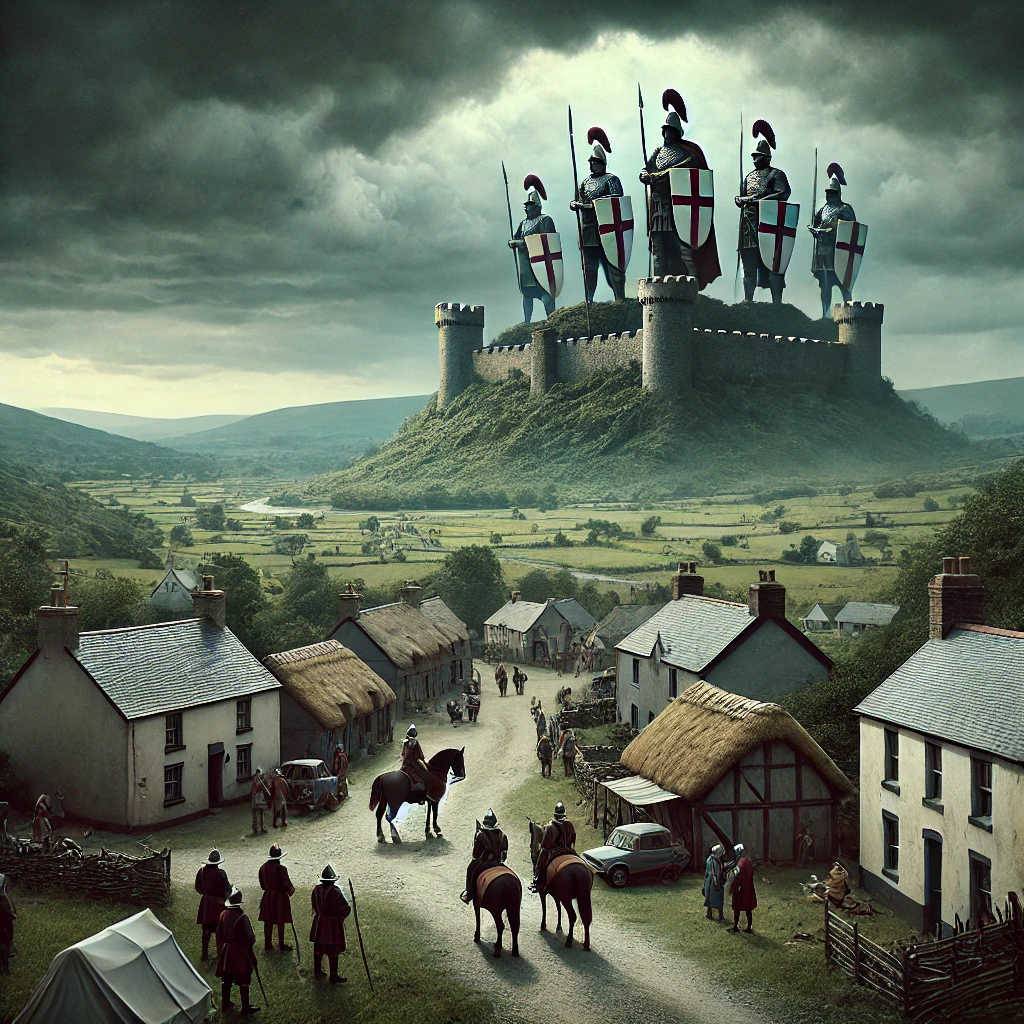
The Acts of Union under Henry VIII marked the formal end of medieval Welsh autonomy, though Welsh language and culture resisted complete assimilation.”
– Ralph Griffiths, The Principality of Wales in the Later Middle Ages
After the Edwardian conquest of Wales between 1277 and 1283, the nation fell under English dominance. Eastern and southern Wales had been conquered earlier, but the impact on north and west Wales was immense. This period caused significant distress to the Welsh national psyche.
The three Welsh princely dynasties of Gwynedd, Deheubarth, and northern Powys were either extinguished or dispossessed. A new system was introduced with centres at Caernarfon, Carmarthen, and Chester. The Statute of Wales, proclaimed in March 1284, solidified English rule. Castles like Harlech, Denbigh, Conway, and Chirk were constructed to control Welsh attacks and reinforce English dominance.
Incorporation into English Legal System
Wales was gradually integrated into the English legal and administrative framework. English law was enforced on the Welsh, and boroughs founded by Edward I became symbols of conquest. Welshmen were barred from these towns and the commercial benefits enjoyed by English burgesses.
Suppression of Welsh Language and Customs
Efforts were made to suppress the Welsh language and cultural traditions in favour of English norms. The conquerors forcibly resettled Welsh landholders in less desirable areas, aiming for cultural assimilation. Despite this, the Welsh people managed to preserve their distinct identity and resist anglicisation.
Edward I’s victory in Wales left lasting scars and amplified national paranoia and resentment. The quest for a unified Wales under a single prince, with leaders like Llywelyn ab Iorwerth and Llywelyn ap Gruffudd, was a recurring theme. A heightened sense of Welsh nationhood emerged, driven by animosity toward the English and pride in Welsh customs, language, and laws.
Welsh Resistance in the Tudor Era
With Henry VII’s ascension to the English throne in 1485, a new era for Wales began. His Welsh roots and support from Wales during the Wars of the Roses were significant. This period saw Wales’s cultural identity and pride flourish, despite remaining politically subordinate to England.
The Tudor era was marked by a renewed interest in Welsh history, language, and traditions. This cultural renaissance was driven by a growing sense of Welsh distinctiveness. Works like The History of Cambria by Humphrey Llwyd and the Welsh Bible translation by William Morgan played key roles in strengthening Welsh identity.
Despite the cultural revival, Wales faced many challenges during the Tudor era. The Principality and the March were subject to English laws and taxes. Fees, fines, prise, and purveyance were imposed on the Welsh population. Welsh herding practices were displaced by English lords, and Welsh self-governance and cultural practices were restricted.
Yet, the Tudor era was foundational for Wales’s national consciousness. The pride in Welsh heritage and achievements during this time helped preserve Welsh culture. This revival, along with a monarch of Welsh descent on the English throne, was a significant step towards Wales’s recognition and autonomy within the British Isles.
Remembering the Medieval Rebellions Of Wales
The medieval Welsh rebellions have left a lasting impact on the nation’s identity. They have shaped its culture and politics for centuries. These uprisings, fought with unwavering determination against English rule, symbolise the Welsh people’s fierce struggle for autonomy and recognition. The memory of these rebellions continues to burn brightly in the hearts of the Welsh, influencing their sense of national identity and pride.
Symbolism in Welsh Culture
The symbols and heroes from the medieval Welsh rebellions have become iconic. The Welsh dragon, a powerful emblem of strength and resilience, adorns the country’s flag. It serves as a constant reminder of the battles fought for freedom. Owain Glyndŵr, the last native Prince of Wales who led a 15-year rebellion against English rule in the early 15th century, is revered as a national hero. His legacy, along with that of other Welsh princes and rebels, is celebrated through art, literature, and folklore. This ensures their stories are passed down through generations.
Influence on Modern Welsh Politics
The impact of the medieval Welsh rebellions extends beyond cultural symbolism, shaping the political landscape of modern Wales. The memory of these uprisings has fueled the desire for greater autonomy and self-determination. This has influenced movements such as the campaign for devolution and the push for increased independence from the United Kingdom. Welsh political parties often invoke the spirit of the rebellions, using the language of resistance and the struggle for identity to rally support for their causes. The legacy of the medieval Welsh rebels serves as a constant reminder of the nation’s proud history and its ongoing fight for recognition and self-governance.
Reflecting on the medieval Welsh rebellions, it’s clear their significance goes beyond the battles themselves. They have become a fundamental part of the Welsh identity. This is a testament to the nation’s resilience, pride, and unwavering determination in the face of adversity. By remembering and honouring these rebellions, the Welsh people keep the spirit of their ancestors alive. This ensures their struggle for autonomy and recognition continues to shape the nation’s future.
Key Takeaways
- Welsh rebellions against English rule were a constant feature of medieval Wales, with iconic figures like Owain Glyndŵr leading the fight for freedom and independence.
- The English occupation of Wales from 1283 under Edward I caused deep resentment among the Welsh population, setting the stage for major uprisings.
- Glyndŵr’s rebellion began in 1400 and quickly gained momentum, with decisive victories against English forces at battles like Mynydd Hyddgen and Bryn Glas.
- The capture of Sir Edmund Mortimer at Bryn Glas led to his alliance with Glyndŵr, further legitimising the Welsh revolt and threatening English control over Wales.
- The medieval Welsh rebellions had a profound impact on the development of Welsh identity and the struggle for independence from English rule.
Conclusion
The medieval Welsh rebellions were a defining moment in the nation’s quest for freedom. They marked a courageous fight against Norman and English rule. Spanning centuries, these uprisings were driven by a strong will to protect Welsh identity, culture, and sovereignty. From Gruffudd ap Cynan’s early battles to Owain Glyndŵr’s legendary revolt, the Welsh showed unwavering resilience and determination.
Though these rebellions did not secure lasting political freedom, their influence on Welsh identity and nationalism is immense. The tales of Welsh princes and rebels who bravely resisted oppression are now a cornerstone of Welsh cultural heritage. These stories inspire and shape the distinct Welsh spirit. The legacy of resistance stands as a symbol of Wales’ enduring strength and pride.
Today, the medieval rebellions of Wales continue to shape Welsh culture and politics. The struggle for freedom and cultural preservation remains central to Wales’ identity. Reflecting on this period, we honour the sacrifices of our ancestors. Their unwavering pursuit of autonomy and identity unites Wales, fostering a shared pride and purpose. This legacy ensures the dream of a free Wales remains alive.
Matt
